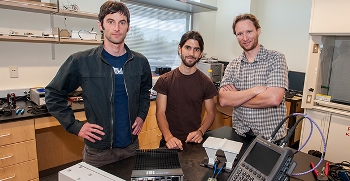May 4 2013
The same Boise State University technology used this year to measure snow accumulation and melt at Bogus Basin is on its way to Greenland to help answer questions about that country’s massive ice sheets.
 Boise State University graduate students Mark Robertson (far left) and Gabriel Trisca, along with researcher Hans-Peter Marshall, gather in their Boise State lab for final preparations before Robertson and Trisca depart for Greenland.
Boise State University graduate students Mark Robertson (far left) and Gabriel Trisca, along with researcher Hans-Peter Marshall, gather in their Boise State lab for final preparations before Robertson and Trisca depart for Greenland.
Boise State graduate students Gabriel Trisca, computer science, and Mark Robertson, geophysics, leave Friday to spend a full month at Summit Camp at Greenland’s highest point, where they will help test the capabilities of a unique NASA robot and gather radar data to help scientists better understand the extent of summer 2012’s unusual ice melt.
The robot will use a radar system, developed by Boise State geosciences assistant professor Hans-Peter Marshall, to measure snow accumulation over the past 30-plus years and help determine how much melt occurred during the extremely warm summer last year when melt occurred at the summit of the Greenland Ice Sheet for the first time since the late 1800s. The robot can be operated remotely and the low-power radar system is unique in that it operates at the same frequency range as NASA satellites, making it unlike anything commercially available.
Dubbed “GROVER,” or Greenland Rover, the robot weighs more than 800 pounds and utilizes two snowmobile tracks and electric motors to traverse the ice. It contains large solar panels and batteries from which it draws its power, and in theory can operate continuously with the radar as long as there is sunlight.
“NASA is very interested in a remote ground unit. They have aircraft and space measurements but nothing capable of taking continual ground measurements,” Marshall said. “This trip is to prove the concept of autonomous ground-based radar measurements on ice sheets. It if goes well, robots like GROVER could be deployed in polar regions around the world and operated from anywhere in the world.”
GROVER was first developed in 2010 and 2011 by teams of students, including Trisca, who participated in NASA’s summer engineering camps. NASA has provided funding to fine-tune the robot at Boise State through several grants led by Marshall that focus on radar measurements of snow. It incorporates the same technology that the Boise State Cryospheric Sciences group has been using this year for NASA snow remote sensing field campaigns in Austria, Alaska and Canada. This campaign in Greenland will be the last of six major NASA snow remote sensing field campaigns that Marshall and a total of six Boise State graduate students participated in this winter.
Boise State was the sole university research group representing the U.S. for the two NASA/ESA snow radar campaigns in Europe. The snow radar has been integrated with GROVER this year and was tested in Idaho this winter in preparation for being deployed to Greenland. This final campaign’s goal is to demonstrate the potential for large-scale, ground-based radar measurements, which could be done at a fraction of the cost of large field campaigns.
“This really is an opportunity for Boise State to demonstrate an exciting new science platform for radar and other measurements in polar regions, which would enable continuous measurements in extremely remote areas,” Marshall said. “I love going to these places, but after over a decade of lots of fieldwork in these isolated areas, the potential for controlling a robot to do the radar measurements for us in Greenland or Antarctica, from my office at Boise State, is pretty exciting.”
Marshall just returned last week from a NASA field campaign in Arctic Alaska on the North Slope of the Brooks range.
Trisca has been writing software for various versions of GROVER for a couple of years.
“This trip to Greenland is such a rare opportunity,” he said. “Computer science doesn’t often have you doing field work in geosciences. I’m really excited to be able to go out and test what I’ve written. Not to mention that we are doing something that has such potential for impacting research in polar regions.”
Trisca also is writing software for detecting snow avalanches, using low frequency microphones, along Idaho Highway 21 between Lowman and Stanley. This local avalanche project with one of Marshall’s Ph.D. students, Scott Havens, is funded by the Idaho Transportation Department. The avalanche starting zones are too dangerous for Marshall’s group to take radar for snow measurements, but next winter they will test a long-range version of the radar system for measuring snow conditions and avalanche speeds to add to the infrasound avalanche measurements.
The Boise State students will meet up with NASA scientist Lora Koenig in Greenland for the research project, and will collaborate remotely with Marshall via email and Skype. NASA will send a reporter to Greenland at the end of May to document GROVER’s progress on the ice sheet.
“Robots like GROVER will give us a new tool for glaciology studies,” Koenig said, adding that research with polar rovers is cheaper than with aircraft or satellites. “If we can control them from our offices, we’ll able to process the data and get scientific results quicker than if we were in the field gathering data, which will speed up our scientific conclusions on what happened that year on the ice sheet.”
Keep up with the Boise State students in Greenland at tog000.com.ar/blog. To view a NASA-produced video of GROVER and learn more about the project, visit http://www.nasa.gov/topics/earth/features/grover.html.